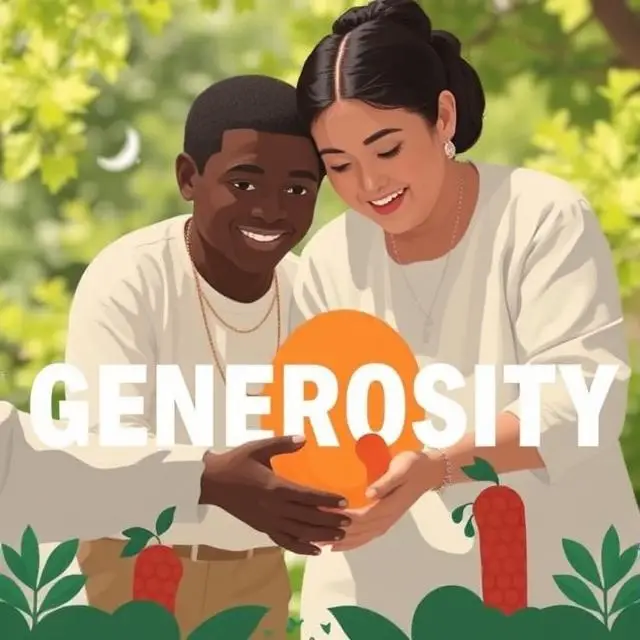Generosity is a fundamental human value that manifests in various forms across cultures, shaping the way people give and receive. The role of culture in influencing generosity is profound, with diverse cultural norms, religious beliefs, and social structures all playing a significant part in how people engage in acts of charity. From communal expectations to individual values, the practices of giving and receiving differ widely around the world, guided by traditions, beliefs, and evolving global trends. Understanding these cultural differences can enhance how generosity is expressed and foster a more compassionate world.
How Cultural Values Influence Generosity Around the World
Cultural values are the core beliefs and principles that shape an individual’s worldview, including their approach to generosity. These values guide how people perceive the act of giving, its importance, and its role in society. Whether influenced by religious teachings, economic systems, or social structures, generosity manifests differently depending on the cultural context.
Individualism vs. Collectivism: Western vs. Eastern Perspectives
One of the primary cultural distinctions that affect generosity is the contrast between individualism and collectivism. In Western cultures, such as the United States and parts of Europe, individualism emphasizes personal achievement and autonomy. Here, generosity is often seen as an individual choice something a person does based on personal conviction, financial capacity, or social awareness. This is reflected in the widespread practice of philanthropy by individuals, including billionaires who contribute to charitable causes either through foundations or direct donations.
In contrast, collectivist cultures, often found in many parts of Asia, Africa, and Latin America, place a greater emphasis on community and group welfare. In these societies, generosity is often framed as a collective responsibility something that enhances group cohesion and ensures the well-being of all. In such contexts, acts of giving may be deeply embedded in social expectations, and people may contribute to communal efforts or support local causes as a form of maintaining social harmony.
Religious Teachings and Their Impact on Charitable Acts
Religion plays a central role in shaping generosity across different cultures. Many major world religions have established principles and practices around giving to those in need, from Zakat in Islam to Tithing in Christianity. These religious teachings not only encourage generosity but also define its moral and ethical underpinnings, making charitable acts an integral part of believers’ lives.
In Islamic culture, for instance, the concept of Zakat (almsgiving) is one of the Five Pillars of Islam, where Muslims are required to donate a percentage of their wealth to those in need. This mandatory giving reinforces the idea that wealth is a communal resource that should circulate within the community to alleviate poverty. Similarly, Christian teachings about helping the less fortunate and the Biblical commandment to love thy neighbor drive many Western charitable initiatives.
The Role of Community and Social Expectations in Giving
In many cultures, giving is not just a personal act but a community expectation. In tightly-knit communities, particularly in rural areas or indigenous groups, generosity is often seen as an essential part of maintaining social bonds. People give to others not only because of personal conviction but also due to the communal obligations of reciprocity. In some cultures, refusing to give when asked may be seen as a breach of social norms, potentially resulting in social ostracization.
The impact of social expectations in shaping generosity is particularly evident in countries with strong community ties, where collective welfare is a priority. In these societies, communal celebrations and festivals often involve acts of generosity, such as providing food, money, or resources to the less fortunate, reinforcing the values of solidarity and mutual support.

Generosity Traditions Across Different Cultures
Across the world, cultures have developed rich traditions and rituals that foster generosity. These customs not only reflect the values of each culture but also highlight the diverse ways in which people practice giving.
Zakat in Islam: A Pillar of Generosity
In Islam, Zakat is a key pillar that encourages Muslims to give 2.5% of their savings and investments annually to help those in need. It is considered both a personal duty and a communal responsibility, reinforcing the idea that wealth should be shared to reduce inequality. Zakat is one of the cornerstones of Islamic generosity, and it has a significant impact on alleviating poverty in Muslim-majority societies. It is seen not merely as an act of charity but as an obligation that purifies the giver’s wealth and soul.
Philanthropy in American Culture: From Billionaires to Grassroots Giving
Philanthropy in the United States has a long history of individual-driven generosity. With a strong emphasis on individualism and the “self-made” ethos, Americans have pioneered large-scale charitable efforts, particularly in the form of foundations and corporate donations. Notable figures such as Bill Gates, Warren Buffet, and Oprah Winfrey have shaped the culture of giving in the U.S., with their substantial contributions to global health, education, and poverty alleviation.
On a grassroots level, charitable organizations, crowdfunding platforms, and local community initiatives thrive in the U.S., reflecting the deep-rooted tradition of charity as a personal choice and a voluntary expression of social responsibility.
Ubuntu in Africa: “I Am Because We Are”
Ubuntu, a Southern African philosophy, highlights the interconnectedness of all individuals. It translates to “I am because we are,” emphasizing that individual well-being is tied to the well-being of the community. In African cultures that embrace Ubuntu, generosity is seen as a reciprocal, communal activity where sharing and giving are vital for maintaining harmony and survival. Generosity in this context is not just about charity but about ensuring the collective good.
Dāna in Hinduism and Buddhism: The Virtue of Selfless Giving
In both Hinduism and Buddhism, Dāna (the act of giving) is a fundamental practice that cultivates selflessness and compassion. In these traditions, giving is considered a moral and spiritual act, bringing benefits not only to the receiver but also to the giver’s soul. In Hinduism, Dāna is believed to purify one’s karma, while in Buddhism, it is seen as an essential practice for attaining enlightenment. The emphasis on selfless giving promotes the idea of generosity as a virtuous cycle, where the act of giving brings spiritual growth and communal harmony.
How Modern Globalization is Changing Cultural Generosity
Globalization has brought cultures closer together, influencing how generosity is perceived and practiced worldwide. Modern communication and technology are transforming the ways people give, creating new opportunities for global philanthropy and cross-cultural exchange.
The Rise of Digital Giving: Crowdfunding and Global Charity
With the rise of the internet, digital platforms like GoFundMe, Kickstarter, and social media channels have made giving more accessible and global. Crowdfunding allows individuals from different parts of the world to contribute to causes that resonate with them, regardless of geographic location. This shift has made philanthropy more decentralized, empowering individuals to support causes directly and raising awareness about global issues.
Cross-Cultural Philanthropy: When Western and Eastern Giving Merge
As Western and Eastern philosophies on generosity converge, a new global approach to philanthropy is emerging. For example, the integration of Western corporate philanthropy with Eastern traditions of communal giving is leading to cross-cultural partnerships and hybrid models of charity. This blending of approaches is not only expanding the scope of giving but also enriching how generosity is practiced and understood in different cultures.
The Influence of Media and Celebrity Activism on Generosity
Celebrity activism and media coverage of global crises have heightened awareness of social and environmental issues, influencing cultural attitudes towards generosity. Public figures like Angelina Jolie, Leonardo DiCaprio, and Malala Yousafzai use their platforms to promote charitable causes, encouraging their followers to donate and get involved. The global reach of social media allows generosity to spread rapidly, breaking down cultural and geographic barriers.
Practical Ways to Encourage Generosity in a Multicultural World
Encouraging generosity in a multicultural world requires understanding the nuances of cultural differences and developing strategies that respect and incorporate these values.
Promoting Cross-Cultural Understanding to Foster Giving
To encourage generosity, it is important to promote cross-cultural understanding. This can be achieved through education, dialogue, and cultural exchange programs that expose people to different values of generosity. By understanding the diverse motivations behind giving, individuals and organizations can create more inclusive charitable initiatives that resonate with a broader audience.
How Businesses and NGOs Can Adapt to Cultural Differences
Businesses and NGOs can encourage generosity by adapting their philanthropic strategies to the cultural contexts in which they operate. This involves not only respecting local traditions of giving but also aligning charitable initiatives with community needs and values. A culturally sensitive approach can help maximize the impact of giving and build trust with local populations.
Teaching Generosity: Cultural Sensitivity in Education
In educational settings, fostering a mindset of generosity involves integrating cultural sensitivity into curricula. By teaching students about the diverse ways generosity is practiced across cultures, educators can instill a deeper sense of empathy and a more global outlook on giving. This promotes the idea that generosity is not just an individual act but a communal value that transcends cultural boundaries.
Conclusion
Culture plays an essential role in shaping generosity, with values, traditions, and social expectations influencing how individuals and communities engage in acts of charity. By understanding these cultural differences, we can build a more compassionate, inclusive world where generosity is not only celebrated but also integrated into everyday life. As globalization continues to evolve, fostering cross-cultural understanding and adapting charitable practices to diverse cultural contexts will be key to creating a more generous and equitable global society.
FAQs: The Role of Culture in Shaping Generosity
1. How does culture influence generosity?
Culture shapes generosity through values, traditions, and social norms. Some cultures emphasize collective well-being (e.g., Ubuntu in Africa), while others focus on individual philanthropy (e.g., Western charity models). Religious beliefs, family structures, and historical practices also play key roles.
2. Which cultures are known for being the most generous?
Studies, such as the World Giving Index, often highlight countries like Indonesia (strong Islamic Zakat traditions), the U.S. (high rates of charitable donations), and Kenya (community-based giving) as some of the most generous. However, generosity manifests differently across cultures.
3. How does religion impact generosity? Many religions encourage giving as a moral duty: Islam mandates Zakat (obligatory almsgiving). Christianity promotes charity as an act of love. Hinduism & Buddhism emphasize Dāna (selfless giving). These teachings shape how people in different cultures approach generosity.
4. Is generosity declining in modern societies?
While some argue individualism reduces traditional generosity, others point to new forms of giving (e.g., online activism, micro-donations). Culture continues to evolve, and so do expressions of generosity.
5. How can I practice generosity in a culturally sensitive way?
Learn about local customs before donating or volunteering.
Support community-led initiatives rather than imposing external solutions.
Ask questions to understand what generosity means in that culture.

